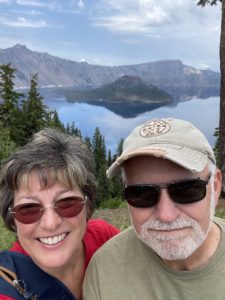
————–
Crater Lake Profile
The lake rests inside a caldera formed 7,700 years ago when a 12,000 foot-tall volcano collapsed following a major eruption. The eruption may have been the latest in
Today, old-growth forests blanket the volcano’s slopes, harboring more than 700 native plant species and at least 72 types of mammals. The park is central to the cultural traditions of local American Indian tribes, whose ancestors witnessed the lake’s formation.
Park established: 1902
Size: 183,224 acres
Number of visitors last year: 648,000
Lake Depth: 1,943 feet deep
Lake Width: 4.5 to 6 miles
Highest Point: Mount Scott, elevation 8,929 feet
——————-
What is the story behind the “Old Man of the Lake”?
The Old Man is a celebrity favorite among visitors and Rangers alike who are always looking to spot him on Crater Lake. Actually, he is not a person at all, but, instead, the Old Man is a 30-foot mountain hemlock log that has, (at least since 1896), floated vertically and continuously in the Lake, with about 3+ feet of the stump above water.
His actual age has been carbon dated to more than 450 years old, though the physics of his upright stance remain a mystery, as do his seemingly random travels across the surface of Crater Lake. Theories on his orientation abound, and though not proven, the commonly held belief is that because the lower part of the tree stump has been in the cold water for over a hundred years, its density has increased, making the Old Man buoyant and balanced.
His travels were first tracked in 1896 by Joseph Diller, an early Park geologist who completed the sketch accompanying this post. The curiosity surrounding the Old Man continued to grow and, in 1938, Washington D.C commissioned a study of his travels. Between July and October, “Old Man” traveled 62.1 miles, an average of .67 miles/day with his maximum daily distance of 3.8 miles achieved on August 6th!
Some believe that the Old Man controls the weather here at Crater Lake and woe be to those who mess with him. As the story goes, in 1988 when the Park brought in a submersible to explore the Lake bottom, the researchers concerned about running into “Old Man”, tied him up on the eastern shore of Wizard Island. Shortly thereafter storms blew in, making it impossible to launch the submersible at all. When this was quickly followed by snow in August, the scientists very quietly, (and under cover of night), released “Old Man” back into the Lake, thus restoring the weather and the Old Man’s freedom.